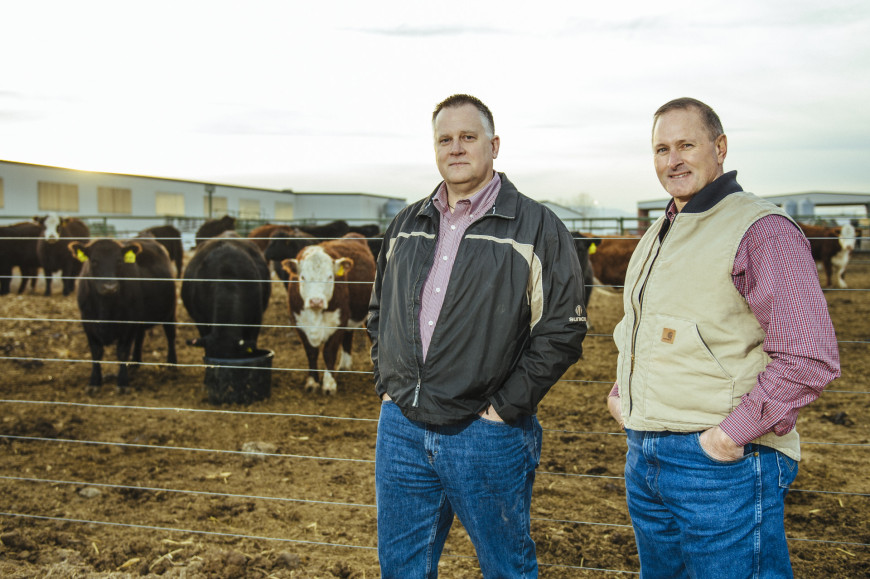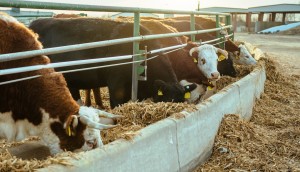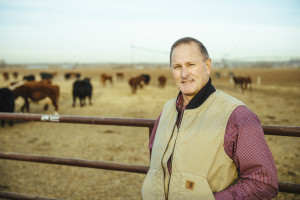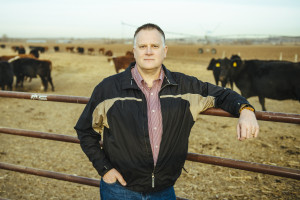
Dr. Paul Morley, left, and Dr. Keith Belk are using DNA sequencing to trace antimicrobial genes in cattle.
Researchers at Colorado State University are investigating the weighty topic of antibiotic resistance – an issue with ramifications for global food safety and public health – by tracking the genetic footprints of drug-resistant bacteria.
They want to determine where infectious organisms originate and how they move through the food system and environment to people. The study, funded with $2.25 million from the U.S. Department of Agriculture, is one of the largest of its kind and is enabled by recent advances in DNA sequencing technology.
The project is expected to provide insights about the factious topic of antibiotic use in food animals, chiefly beef and dairy cattle, and the degree to which the longstanding agricultural practice contributes to development of “superbugs” that infect people whose illnesses are difficult and expensive to treat.
“Antimicrobial resistance is one of the most significant grand challenges to human animal and food safety,” said Alan Rudolph, CSU vice president for research. “This award highlights how Colorado State University is poised as a premier land-grant research institution to pursue novel solutions to this important societal problem.”

Each year in the United States, at least 2 million people become infected with bacteria that are resistant to antibiotics; at least 23,000 people die each year as a direct result of these infections, according to the federal Centers for Disease Control and Prevention. Salmonella and Campylobacter, two of the many bacteria commonly transmitted through food, cause an estimated 410,000 antibiotic-resistant infections in the country each year, the CDC reports.
Antibiotic, or antimicrobial, resistance is gaining increasing attention as a global public-health threat: Just four months ago, the White House directed key federal agencies to coordinate on a “National Strategy to Combat Antibiotic-Resistant Bacteria.” In November, the Association of Public and Land-Grant Universities and the Association of American Veterinary Medical Colleges announced a new Task Force on Antibiotic Resistance in Production Agriculture to provide advice and education.
Food-animal production has been blamed for contributing to antimicrobial-resistant illness, but these suspicions are not well-founded in science, said Keith Belk, professor in CSU’s Center for Meat Safety and Quality, and Dr. Paul Morley, a CSU veterinarian and infectious-disease expert.
With multiple collaborators, the two are leading the research project, “Paradigm Shift: Revolutionizing Our Understanding of Antimicrobial Resistance Ecology through Whole Genome Analysis of Microbial Communities.”

The scientists hope to gain a much better understanding of the role of production agriculture in antimicrobial resistance. It often is assumed that providing antibiotics in feed rations for livestock contributes to drug-resistant germs, but the practice also has a protective effect, Belk said.
“Most people believe they are consuming antimicrobial-resistant bacteria in their food because of intensive food production systems. In fact, those modern food-production systems are effectively controlling bacteria in food,” Belk said.
Antibiotics – used in agriculture and by countless people around the world – kill dangerous bacteria and other germs. Yet surviving infectious agents replicate, producing greater antimicrobial resistance, or AMR.
“Use over time promotes increasingly resistant populations that may threaten public health because bacteria susceptible to the antibiotics die, while those that are not survive,” Morley explained.
In order to successfully solve the problem of antibiotic resistance, scientists must better understand where resistance originates and how drug-resistant germs move through the food system and environment to people, the CSU researchers said.
“There’s not a farmer in the world who doesn’t take pride in their product,” Morley said, adding that it is in agriculture’s best interest to understand if and how livestock production contributes to drug-resistant germs in people. “We are looking at production methods to see if they have an impact on AMR promotion, and if they do, we’ll need to change those production methods — within reason — as an industry.”

Using DNA sequencing technology, the two professors will trace genes that cause resistance in bacteria. This will allow them to determine sources and paths, including whether and how antimicrobial-resistant bugs move from livestock to humans.
The cost of advanced genetic-sequencing technology has dropped dramatically in the past decade, allowing researchers to conduct more thorough examinations of the hundreds of millions of bacteria that can be found in a single sample of cow feces, for instance.
Belk and Morley will compare antimicrobial resistance in traditional and organic processes, and in different environments, to identify what resistant genes are present and how they are transferred. They also want to learn whether different production methods affect abundance of antimicrobial resistance.
“This is collaborative work,” Belk said. “It’s truly a team effort. We will use what we learn to help train a new generation of scientists in the power of using these new DNA sequencing capabilities to address societal issues.”
Partners on the three-year project include the CSU departments of Computer Science; Environmental and Radiological Health Sciences; Education; and Food Science and Human Nutrition. Others include the Colorado School of Public Health, University of Colorado Health Sciences Center, Public Health Agency of Canada, USDA’s Animal and Plant Health Inspection Service, and industry collaborators providing access to their animals.